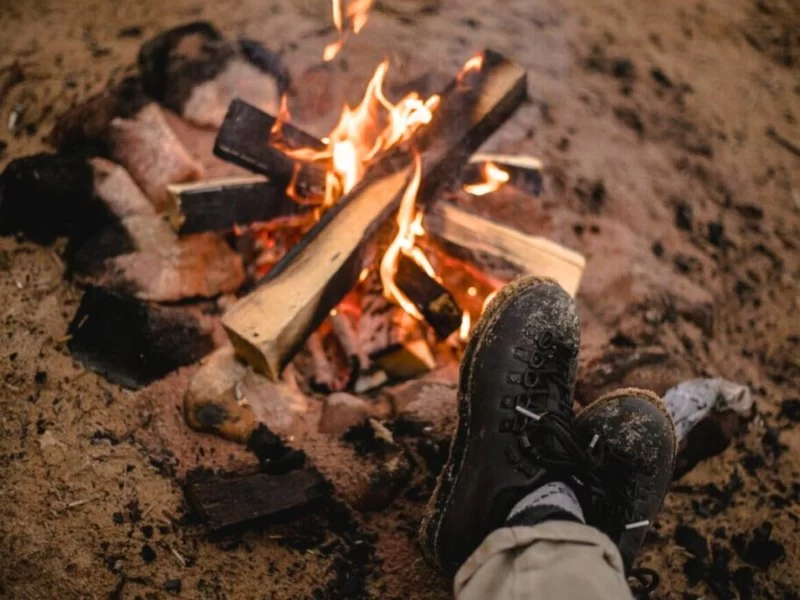- 1 - teepee-campfires-structure-and-purpose
- 2 - log-cabin-fire-type-for-long-burns
- 3 - star-fire-type-efficient-and-rustic
- 4 - platform-fire-best-for-cooking-use
- 5 - lean-to-campfire-wind-resistant-style
- 6 - tips-on-building-and-extinguishing-campfires
1. Teepee Campfires: Classic Structure and Quick Start
Among the most recognizable and beginner-friendly options, the teepee-style campfire is a favorite for a reason. It uses a cone-shaped layout where small twigs and kindling are stacked inside a circle of larger sticks leaning against each other, resembling a Native American teepee.
This shape allows airflow to reach the fire’s core easily, resulting in a fast ignition and high flame. It’s perfect for warming up quickly or boiling water. However, it also burns quickly, meaning it’s not ideal for long-term use unless you’re constantly adding fuel.
Campers often describe their first teepee fire as a moment of real satisfaction. One family staying at Pine Cliff Resort shared that their children were able to help build one with minimal guidance — turning fire-starting into a bonding moment.
2. Log Cabin Fire: Reliable and Long-Lasting
Looking for a campfire that can last for hours with minimal tending? The log cabin fire is your go-to. This structure mimics the build of an actual log cabin — you alternate logs perpendicularly in a square shape, gradually building layers, with tinder and kindling placed in the center.
The open center and structured airflow make it a stable burner. It’s ideal for group gatherings and slower cooking methods, like roasting marshmallows or simmering chili over a grate.
This fire type was a lifesaver for a group of hikers caught in unexpected rainfall at a remote campsite near Lake Kashagawigamog. They recounted online how their log cabin fire, once covered with a makeshift tarp, kept going through damp conditions and saved them from a miserable night.
If you're planning for long evenings outdoors or off-grid adventures, Pine Cliff Resort offers camping gear rentals suited for these setups.
3. Star Fire: Efficient and Perfect for Minimalists
The star fire is often seen in survival situations or by minimalist campers who want to control burn rate and conserve firewood. Long logs are arranged in a radial pattern — like a star — with their ends meeting at the center where the fire burns.
As the logs burn, you simply push them inward. This fire is highly efficient and allows for prolonged heat without a lot of maintenance. It also works well on rocky or uneven terrain where other structures are harder to build.
An Appalachian Trail solo traveler shared in her blog how a star fire kept her warm for two nights on minimal wood during a dry spell. She even used the outer logs as makeshift benches.
For campers interested in practicing traditional firecraft techniques, Pine Cliff Resort occasionally hosts wilderness skills workshops where you can learn to build and manage a star fire in a safe, hands-on environment.
4. Platform Fire: Cooking Made Clean and Easy
A favorite among wilderness chefs, the platform fire is built on a raised surface of thick green logs, forming a flat "table" where kindling and small logs are lit on top. As the fire burns down, it creates a hot bed of coals ideal for cooking.
Because it burns from top to bottom, it produces less smoke and provides a clean, steady heat source. Backpackers who prefer cast-iron skillet cooking often rely on platform fires for everything from pancakes to grilled trout.
A former military survival instructor once demonstrated this fire type during a family weekend retreat at Pine Cliff Resort, impressing kids and adults alike with perfectly seared lake fish and grilled mushrooms over a homemade fire table.
5. Lean-To Campfire: Built for Windy Conditions
When camping in windy or unpredictable weather, the lean-to fire offers practical benefits. A large log acts as a windbreak, with kindling and small sticks leaned against it. This setup creates a small but intense flame protected from gusts.
It’s ideal for quick warmth or starting fires in challenging weather. Because it’s low to the ground and compact, it’s also safer in dry or wooded areas.
On a particularly brisk October evening, campers at Pine Cliff Resort successfully used the lean-to method to cook hot dogs during a surprise lakefront windstorm. The fire held steady, and the memory became one of those "remember when..." moments they still talk about today.
6. Practical Tips on Building and Extinguishing Campfires
Building a good campfire is about more than striking a match. Here’s what you need to know to stay safe, respectful, and efficient:
- Choose the right location: Use established fire pits when available. Keep fires away from dry grass, tents, or overhanging branches.
- Use dry wood: Wet wood smokes heavily and is harder to light. Keep a stash of kindling and small twigs to help get things started.
- Keep safety gear nearby: Always have water or a shovel nearby to extinguish flames if needed.
- Fully extinguish before leaving: Pour water over the fire, stir the ashes, and repeat until the area is cool to the touch. Never leave a fire unattended.
Campfires connect us to tradition, survival, and each other. Whether you’re a first-time camper or a seasoned outdoorsperson, understanding the different types of campfires gives you more than just warmth — it opens up possibilities for safety, cooking, storytelling, and memory-making.
To explore the best fire-ready campsites, workshops, and gear options, check out what Pine Cliff Resort has to offer for your next outdoor journey.







